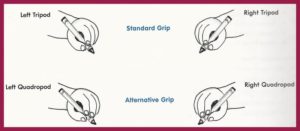One of the first things Occupational Therapists look at when they see someone writing is their pencil grasp. This becomes automatic and we frequently find ourselves assessing the pencil grasp of the lady behind the counter in the bank or the person taking our order at a restaurant.
The reason that this become so engrained in the minds of Occupational Therapists is that when we see a child for handwriting difficulties one of the first things we need to look at is how they are holding their pencil and how this is affecting their writing. There are many different ways that we hold our pencils, some of these work well for us and others impact significantly on the legibility and pace of our writing or the amount of writing we can do before it becomes painful. The most common pencil grasps are the Tripod and Quadropod grasp (See Below). Until recent times these were considered to be the only acceptable grasps that should be used when writing but more and more the literature is telling us that you shouldn’t worry about a pencil grasp unless it is affecting the speed or legibility of the child’s writing or they are experiencing pain.
Children can hold their pencils incorrectly for a number of reasons;
- They may not have been taught how to hold it correctly
- They may have poor fine motor skills
- They may not find the grasp comfortable
It is important that we help children build their fine motor strength and dexterity to enable them to hold their pencils correctly we can do this with some simple games and day to day adjustments;
- Use resistance putty (Theraputty) to help them build general hand strength. Finding hidden coins in putty and then using a pincer grasp to post these into a money box. Then rolling out the putty into a long snake and pinching it to make dragon scale, it’s important to make sure they use a pincer grip when doing this and not a key grip.
- Use tweezers with your child. Encourage them to have three fingers on the tweezers and the last two fingers tucked in. You can give them something to hold with the last two fingers if they are having difficulty with this. It’s great fun to use tweezers at snack time as children are motivated by treats and novelty. Grapes, raisins, popcorn, Maltesers and jellies work great.
- When your colouring with your child, break all of the crayons into small pieces. Using short stubby crayons naturally encourages a tripod grasp.
- Try to encourage your child to rest the ulnar side (the little finger) of their hand on the page when they are writing or colouring. This helps to stabilise the hand.
- Using a mini stylus when on tablets or phones will also help to encourage a more functional grasp as this follows the same principle as using smaller crayons.
- Teach correct pencil grasp using a song or rhyme. Handwriting Without Tears use the crayon song to teach correct grasp and children love to sing and practice with the song. You can get this song on their Get Set For School CD and the words are on the book inside the case.
If children continue to struggle with holding their pencils in a functional grasp I will recommend using a pencil grip to encourage this. Different grips work better for different children and there is a certain amount of experimenting needed to find one that suits. I use a plain foam grip on my pencil as my grasp is tight and this reduces pain when I’m writing.
I frequently recommend the grotto grip or the claw grip. These are good if the child is struggling in relation to where to place their fingers or if they have a tendency to wrap their thumb over the pencil and index finger. Other children simply need a grip that will prompt them about where to place their fingers.
Written By Amanda Kelly, Senior Occupational Therapist, Sensational Kids
Copyright Sensational Kids CLG


